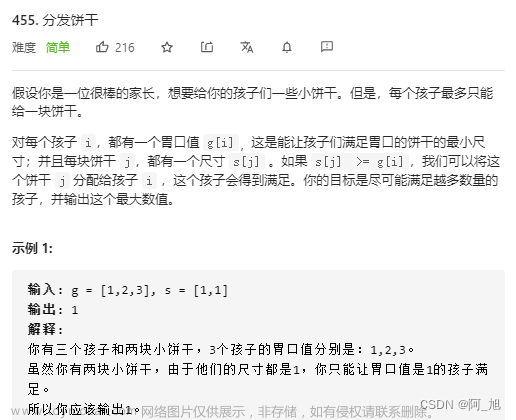Description
给定一个非负整数数组 nums ,你最初位于数组的 第一个下标 。
数组中的每个元素代表你在该位置可以跳跃的最大长度。
判断你是否能够到达最后一个下标。
Intro
Ref Link:https://leetcode.cn/problems/jump-game/
Difficulty:Medium
Tag:Array、Dynamic Programming
Updated Date:2023-07-15
Test Cases
示例1:文章来源:https://www.toymoban.com/news/detail-589217.html
输入:nums = [2,3,1,1,4]
输出:true
解释:可以先跳 1 步,从下标 0 到达下标 1, 然后再从下标 1 跳 3 步到达最后一个下标。
示例 2:文章来源地址https://www.toymoban.com/news/detail-589217.html
输入:nums = [3,2,1,0,4]
输出:false
解释:无论怎样,总会到达下标为 3 的位置。但该下标的最大跳跃长度是 0 , 所以永远不可能到达最后一个下标。
提示:
1 <= nums.length <= 3 * 104
0 <= nums[i] <= 105
思路
- 动态规划
Code AC
class Solution {
public boolean canJump(int[] nums) {
// Space Complexity Optimization O(n) -> O(1)
int maxJumpIndex = nums[0];
for (int i = 1; i < nums.length; i++) {
if (i > maxJumpIndex) return false; // can not reach here anymore
maxJumpIndex = Math.max(maxJumpIndex, i + nums[i]);
}
return maxJumpIndex >= nums.length - 1 ? true : false;
}
public boolean canJump1(int[] nums) {
// define dp[i] can jump max distince index value when at index i
int[] dp = new int[nums.length];
dp[0] = nums[0];
for (int i = 1; i < nums.length; i++) {
if (i > dp[i-1]) return false; // can not reach here anymore
dp[i] = Math.max(dp[i-1], i + nums[i]);
}
return dp[nums.length - 1] >= nums.length - 1 ? true : false;
}
public boolean canJump(int[] nums) {
if(nums == null | nums.length == 0) return false;
boolean[] f = new boolean[nums.length];
f[0] = true;
for(int i=1; i<nums.length; i++){
for(int j=0; j<i; j++){
if(f[j] && nums[j]+j>=i){
f[i] = true;
break;
}
}
}
return f[nums.length-1];
}
}
Accepted
172/172 cases passed (2 ms)
Your runtime beats 91.57 % of java submissions
Your memory usage beats 65.84 % of java submissions (42.4 MB)
复杂度分析
- 时间复杂度:O(n)
- 空间复杂度:O(1)
到了这里,关于Killing LeetCode [55] 跳跃游戏的文章就介绍完了。如果您还想了解更多内容,请在右上角搜索TOY模板网以前的文章或继续浏览下面的相关文章,希望大家以后多多支持TOY模板网!









